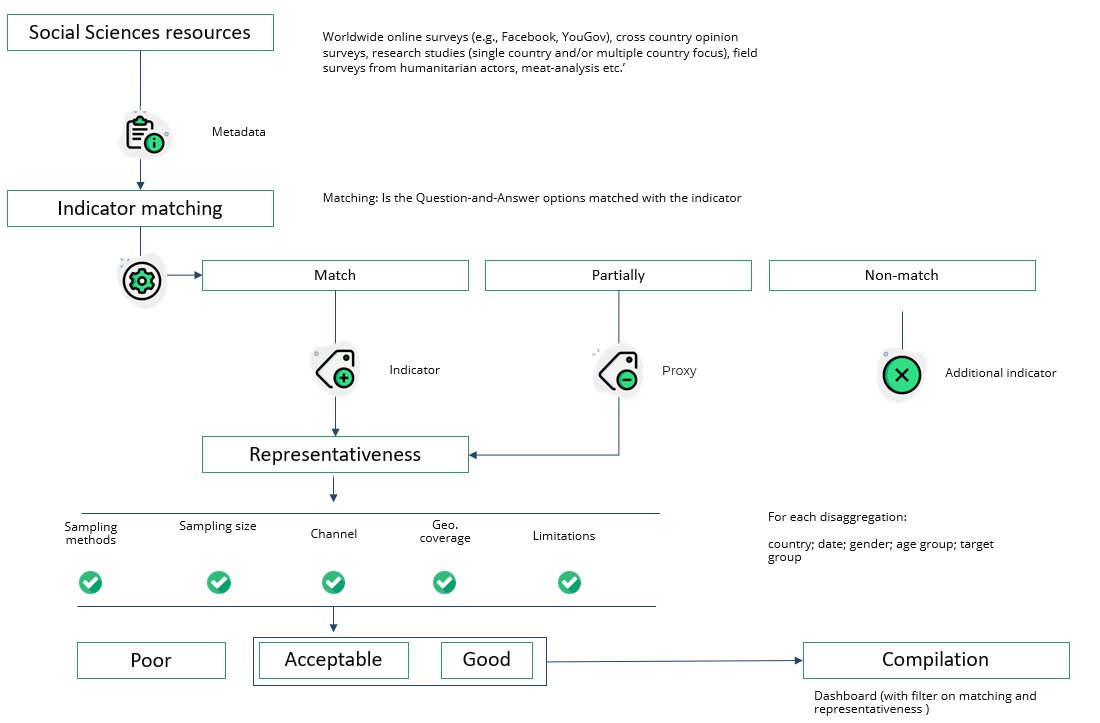COVID-19 BEHAVIOURAL INDICATORS
Introduction
The COVID-19 behavioural data dashboard aims to support partners engaged in policy, practise and research so they can access key social and behavioural data which will inform their COVID-19 response. It compiles, structures and measures data generated through research at the national and sub-national, regional and global levels.
The dashboard aims to track how information, knowledge, perception, and practices are changing in the context of COVID-19 – from January 2020. This monitoring tool has four objectives:
- Gathering existing and validated social and behavioural data from a large spectrum of data sources.
- Exploring social and behavioural trends across six dimensions and 35 indicators (see COVID-19 behaviour change framework).
- Tracking socio-behavioural changes over time and by country.
- Displaying indicators disaggregated for example by gender, age and specific population groups, if data is available (e.g. migrants, health workers, etc.).
The dashboard consists of:
- Global and regional data: key figures such as a global percentage and a global trend of the selected indicator, a timeline for the latest 12 months, as well as regional percentages of selected indicator.
- National data: a map displaying the national average, country ranking by the selected indicator, and a table with the monthly average for each country.
- List of data sources.
Data is continuously compiled and processed and data visualization methods updated which might result into periodic changes of the information presented in the dashboard. The dashboard is available here.
COVID-19 Behavioural Change Framework
The dashboard is underpinned by the COVID-19 behavioural change framework and related RCCE core indicators. This framework has been developed in consultation with RCCE partners, including technical experts and is rooted in the UNICEF behavioural driver model. For each socio-behavioural and structural dimension, a set of variables has been developed.
The database of the dashboard is structured through the 35 RCCE core indicators and categorieed in six dimensions which are considered to be the most relevant in understanding how perceptions, knowledge and practices, and social and structural variables are influencing the uptake of positive health behaviours.
Data Sources
Data has been extracted from fieldwork assessments, phone-based and/or web-based Knowledge, Attitude and Practice (KAP) surveys and global opinion polls (phone and/or web-based). The data sources include academic and peer-reviewed research articles and other publicly available studies, as well as RCCE partner-led KAP surveys and/or field assessments using a robust methodology.
Link to data sources.
Data Selection
Data have been selected according to the following workflow:

Indicator matching
To compare data from different data sources, we match the survey question with the respective RCCE core indicator. We defined three levels that determine the extent to which the survey questions correspond with the indicator: ‘Fully match’, ‘Partially Match’, and ’Do not match’. The COVID-19 behavioural data dashboard only includes data from survey questions that fully matched an indicator, for example, the table below shows how various existing survey questions matched the ‘percentage of individuals who would get vaccinated once a vaccine is available and recommended’.
| Question | Classification |
| If a new Coronavirus (COVID-19) vaccine became publicly available and was deemed safe and effective, do you think you would take it? Yes | Match |
| If parents accept COVID-19 vaccination for their children – Very likely, Likely | Partially match |
| If the vaccine was 95% effective, would you like to be vaccinated when it is provided freely by government? – Yes | Partially match |
| How willing they would be to get a COVID-19 vaccine if it was free or covered by health insurance? – Definitely willing; Probably willing | Partially match |
| When a COVID19 vaccine becomes available, will you get vaccinated if it is recommended and paid out of pocket? | No-match |
Representativeness
For each of the data sources we analysed several criteria to identify limitations and classify the level of representativeness:
| GOOD No Limitation |
ACCEPTABLE Limitation |
POOR Reject |
|
| Sample size | Sample has more than 380 respondents by subgroup | If one of the subgroups in the sample has less than 380 respondents | The total sample size is has less than 380 respondents |
| Sample method | Simple random, stratified, post stratified, clustered methods | Convenience, Quota, Judgment or Snowballing sampling | If sample size is poor and if there are limitation in sample methods or no methods described |
| Channel | Face-to-face, phone-based, computer-based or internet-based | In contexts which are primarily characterised by a rural population and/or high illiteracy rate, computer-based or internet-based survey present limitation | |
| Geographic coverage | National coverage | Some limitations are observed on the geographic coverage | Survey focusing only on one geographic area |
| Other limitations | – | Acceptable limitations are observed or reported by the authors or peers | Critical limitations observed or reported by the authors or peers |
Calculation
Data used
We are compiling primary data (original result datasets) when available and secondary data from publicly available reports or publications. Disaggregation data are reported if available. No raw data has been used for the dashboard.
According to the representativeness criteria (see above), we use data with good and acceptable representativeness levels.
Aggregation
Behavioural indicator data are mainly collected at the country level using different timeframes. In order to compile and monitor these indicators in a standard framework, we aggregated country-level data on a monthly basis. Additionally, to allow comparison of regional and global trends, we performed geographic aggregations at the global with regional level.
Country percentage
To monitor indicators at the country level, we aggregate all reported values by month. The reference date is the end date of the survey.
In cases where several values are reported for the same month, from one or many data sources, we calculated an arithmetic mean from all recorded values. The result is considered as monthly percentage for the indicator and this country.
Regional percentage
The regional percentage is the weighted average of country percentages for each country with a value within the selected region, and during the selected period (by default the latest three months ). The regional percentage is then calculated for each region, defined by RCCE Collective Service as:
Global percentage
The global percentage is the weighted average of all country percentages for each country with a value during the selected period (by default the last three months). The global percentage is then calculated as:
Version: 1.2
Date: 30/06/2021

